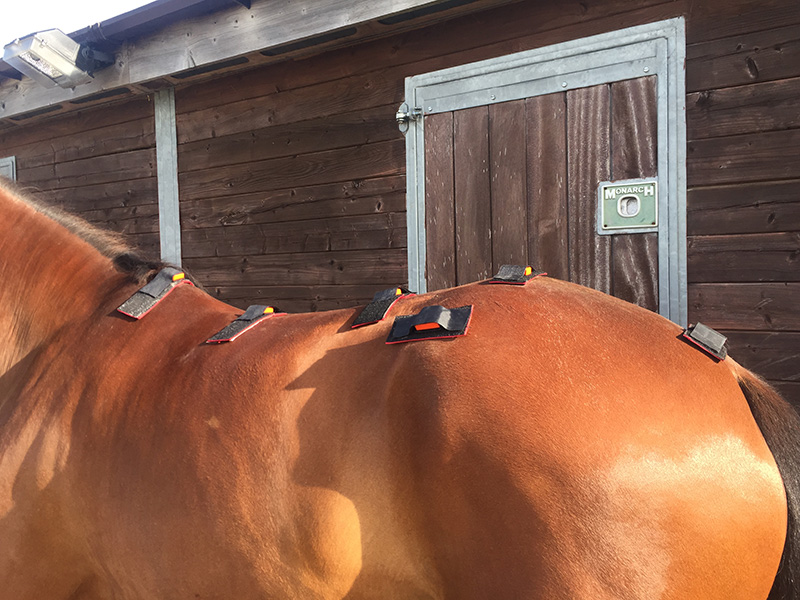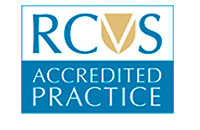24 hour contact: 01707 666297
Sensor technology allows experts to enhance understanding of the relationship between lameness and back problems in horses
Sensor technology is allowing experts from the RVC and Animal Health Trust to enhance their understanding of the relationship between lameness and back problems in horses.
It has long been acknowledged that horses with lameness often also present back problems, and horses diagnosed with back problems also show limb related lameness. The interaction between the two is bio-mechanically complex, and how lameness may lead to back problems or how back problems may create lameness is comparatively poorly understood.
In recent years, considerable progress has been made in the detection of lameness, in particular with the advent of sensor-based gait analysis that can now be conducted effortlessly in conjunction with the clinical veterinary lameness exam.
Now, multi-sensor inertial sensor systems are allowing experts to quantify back movement parameters as well as the ‘traditional’ lameness parameters. This enables them - without the need for a dedicated and expensive gait laboratory – to construct the most precise analysis yet of the interactions between different anatomical parts in lame horses, ranging from almost imperceptible asymmetries to extreme limps. Crucially, inertial sensors are small, lightweight and easily attached to the horse meaning that assessments of back movement can also be conducted in clinical cases, allowing us to study the effect of changes in movement asymmetry (lameness) on back movement.

In a new study using these multi-sensor inertial sensor systems, thirteen horses with hind limb lameness were trotted in straight lines and lunged on a 10m diameter circle on left and right reins, before and after lameness was substantially improved by diagnostic analgesia (induced numbness to eliminate pain). Data on gait asymmetry and ranges of motion were collected from along the spine of the horse from the head to the base of the tail as well as from left and right hips.
The results indicate that:
- Immediately after resolution of lameness, hip movement asymmetry (a traditional indicator of lameness) improved by on average 7%.
- Movement asymmetry along the back decreased significantly by between 33% and 52% across pelvis, lumbar and mid thoracic region.
- The range of motion of the back showed a clear increase, particularly in the mid thoracic and lumbar region, indicating that removing limb related pain allows the horses to move more freely through their back.
Dr.-Ing. Thilo Pfau, Senior Lecturer in Bio-Engineering at the RVC and supervisor of PhD student Line Greve who conducted this research project, said: “The observation that reductions in limb-related lameness immediately resulted in increased ranges of motion of the back can be seen as a model for the inverse process: when a horse develops a limb related lameness, this impedes movement patterns across the body. The back, as the bio-mechanical link between forelimbs and hind limbs, appears of particular interest here.
“It is well documented that horses with hind limb lameness show compensatory head movements, and we have recently shown that the movement of the withers plays an important role in the process of distinguishing between forelimb and hind limb lame horses.
“We strongly believe that back movement plays a central role in horses with poor performance and that more research needs to be conducted elucidating back movement as a function of treatment and rehabilitation regimens, such as our recent study on the effect of elastic exercise bands.”
The RVC equine referral hospital is currently investing in an exciting upgrade of its gait analysis facilities. Aided by funding from the RVC Animal Care Trust, this will enable the combination of the RVC’s state-of-the-art inertial sensor system with a state-of-the-art 3D camera system to provide unique 3D data on back posture and range of movement as well as movement asymmetry. These facilities, combined with the expertise of one of the world’s leading animal biomechanics laboratories, the Structure and Motion Lab, put the RVC in the unique position to offer truly evidence-based decision making for horses with poor performance based on world-class facilities.
Press Office Contact
Uche Graves / Zoe Chadwick
T: 0800 368 9520
E: uche.graves@plmr.co.uk / zoe.chadwick@plmr.co.uk
Notes to Editors
The °ÄĂĹÁůşĎ˛ĘąćÂÉÂŰĚł (RVC) is the UK's largest and longest established independent veterinary school and is a constituent College of the University of London. The RVC offers undergraduate, postgraduate and CPD programmes in veterinary medicine, veterinary nursing and biological sciences, being ranked in the top 10 universities nationally for biosciences degrees. It is currently the only veterinary school in the world to hold full accreditation from AVMA, EAEVE, RCVS and AVBC.
A research-led institution, in the most recent Research Excellence Framework (REF2014) the RVC maintained its position as the top HEFCE funded veterinary focused research institution.
The RVC also provides animal owners and the veterinary profession with access to expert veterinary care and advice through its teaching hospitals; the Beaumont Sainsbury Animal Hospital in central London, the Queen Mother Hospital for Animals (Europe's largest small animal referral centre), the Equine Referral Hospital, and the Farm Animal Clinical Centre located at the Hertfordshire campus.
RVC Press Release 28 June 2017
See other .

